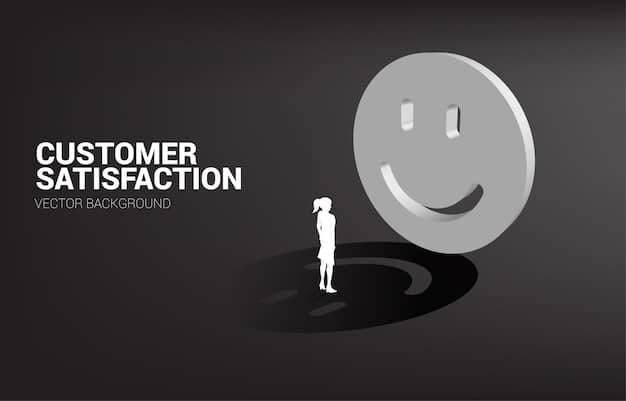Turn Customer Complaints into Opportunities: Boost CX & Loyalty

Turn customer complaints into opportunities by learning how to transform negative feedback into actionable strategies. This approach improves customer experience (CX) and fosters brand loyalty by addressing concerns effectively and demonstrating a commitment to customer satisfaction.
Customer complaints, often viewed as negative experiences, can actually be valuable opportunities for growth and improvement. Understanding how to turn customer complaints into opportunities is a crucial strategy for not only enhancing customer experience (CX) but also fostering long-term brand loyalty. Complaints offer direct insights into areas where your business can improve, allowing you to fine-tune your processes, products, and services to better meet customer needs.
Why Customer Complaints Are Opportunities in Disguise
Treating customer complaints as mere annoyances is a missed opportunity. Instead, viewing them as valuable feedback can lead to significant improvements. By listening to and acting on customer concerns, you can enhance your offerings and build stronger relationships. This proactive approach not only resolves immediate issues but also demonstrates that your business values customer input and is committed to providing exceptional service.
Uncovering Hidden Issues
Customer complaints often highlight problems that might otherwise go unnoticed. These issues could range from product defects to inefficient processes. By addressing these concerns promptly, you can prevent similar problems from affecting other customers in the future.
Improving Customer Satisfaction
When customers see that their complaints are taken seriously and resolved effectively, their satisfaction levels increase. This positive experience can turn dissatisfied customers into loyal advocates for your brand. It shows them that you care about their concerns and are willing to go the extra mile to meet their needs.
- Identify recurring issues: Track complaints to spot trends and common problems.
- Implement process improvements: Use feedback to streamline operations and enhance service delivery.
- Enhance product quality: Address defects and improve product design based on customer input.
By taking a proactive and responsive approach to customer complaints, you can transform potential negatives into positives. This not only enhances customer satisfaction but also drives business growth and strengthens your brand reputation.

Effective Strategies to Turn Customer Complaints into Opportunities
Turning complaints into opportunities requires a strategic approach. This involves actively listening to customers, responding thoughtfully, and implementing changes based on the feedback received. By adopting effective strategies, businesses can not only resolve issues but also create positive experiences that strengthen customer relationships.
Active Listening and Empathy
The first step in handling customer complaints is to listen attentively and empathetically. Customers want to feel heard and understood. Acknowledge their concerns and demonstrate that you genuinely care about resolving their issues.
Timely and Thoughtful Responses
Responding promptly to customer complaints is crucial. A delayed response can exacerbate the situation and further frustrate the customer. Provide a thoughtful and personalized response that addresses their specific concerns and offers a resolution.
Implementing Feedback-Driven Changes
One of the most important steps is to implement changes based on the feedback received. This shows customers that their opinions matter and that you are committed to continuous improvement. Track the impact of these changes to ensure they are effective.
Turn customer complaints into opportunities by viewing them as valuable insights. This approach not only resolves immediate issues but also drives continuous improvement and fosters brand loyalty.
How to Build Brand Loyalty by Addressing Complaints
Building brand loyalty is a primary goal for many businesses, and effectively addressing customer complaints plays a significant role in achieving this. When customers see that their concerns are valued and resolved, they are more likely to develop a positive relationship with the brand. This positive perception translates into increased loyalty and repeat business.
Creating Positive Experiences from Negative Ones
Transforming a negative experience into a positive one can have a lasting impact on customer loyalty. By exceeding expectations in handling complaints, you can create a memorable experience that strengthens the customer’s connection to your brand.
Turning Dissatisfied Customers into Advocates
A well-handled complaint can turn a dissatisfied customer into a brand advocate. These advocates are more likely to recommend your business to others, contributing to organic growth and positive word-of-mouth marketing.
Strengthening Customer Relationships
Addressing complaints effectively improves customer relationships, showing that you value their feedback and are committed to providing excellent service. This proactive approach builds trust and fosters long-term loyalty.
- Solicit feedback regularly: Proactively ask for feedback to identify potential issues early.
- Personalize your responses: Tailor your responses to address each customer’s specific concerns.
- Offer proactive solutions: Go the extra mile to resolve issues and exceed customer expectations.
By consistently addressing customer complaints in a positive and effective manner, you can build a loyal customer base that supports your business and contributes to its long-term success. Remember that turn customer complaints into opportunities is not just about fixing problems; it’s about building relationships.

The Role of Technology in Managing Customer Feedback
Technology plays a crucial role in effectively managing customer feedback and turning complaints into opportunities. Various tools and platforms can streamline the process of collecting, analyzing, and responding to customer concerns. By leveraging technology, businesses can improve their efficiency and provide better customer support.
Customer Relationship Management (CRM) Systems
CRM systems are essential for tracking and managing customer interactions, including complaints. These systems provide a centralized repository for customer data, allowing businesses to personalize their responses and resolve issues more effectively.
Feedback Collection Tools
Various tools are available for collecting customer feedback, such as surveys, online forms, and social media monitoring. These tools help businesses gather valuable insights into customer perceptions and identify areas for improvement.
Analytics and Reporting
Analytics and reporting tools can help businesses analyze customer feedback data to identify trends and patterns. This information can be used to prioritize issues and implement targeted improvements.
Embracing technology helps to turn customer complaints into opportunities with efficiency and precision. Use insights from feedback to optimize customer experience and build stronger brand loyalty.
Measuring the Impact of Complaint Resolution
Measuring the impact of complaint resolution is essential for understanding the effectiveness of your strategies and identifying areas for improvement. By tracking key metrics, businesses can assess the ROI of their complaint resolution efforts and ensure they are delivering value to their customers.
Customer Satisfaction Scores (CSAT)
CSAT scores provide a direct measure of customer satisfaction with your products, services, and support. Tracking CSAT scores before and after implementing changes based on customer feedback can help you assess the impact of your efforts.
Net Promoter Score (NPS)
NPS measures customer loyalty by asking customers how likely they are to recommend your business to others. Improvements in NPS can indicate that your complaint resolution strategies are effectively building brand loyalty.
Customer Retention Rates
Customer retention rates measure the percentage of customers who continue to do business with you over time. Increased retention rates can indicate that your efforts to address customer complaints are contributing to long-term customer loyalty.
- Track key metrics: Monitor CSAT, NPS, and retention rates to assess the impact of your complaint resolution strategies.
- Analyze feedback themes: Identify recurring themes in customer feedback to pinpoint areas for improvement.
- Conduct regular reviews: Regularly review your complaint resolution processes to ensure they are effective and efficient.
Consistently measuring the impact of your complaint resolution efforts allows you to optimize your strategies, improve customer experience, and drive long-term business growth. Don’t underestimate the power to turn customer complaints into opportunities through careful analysis and strategic action.
| Key Point | Brief Description |
|---|---|
| 💡Active Listening | Pay attention to customer concerns with empathy to understand the issue fully. |
| 🛠️ Timely Response | Address complaints quickly to prevent customer frustration and show responsiveness. |
| 📈 Feedback Implementation | Use customer feedback to drive changes and improve products and services continuously. |
| 📊 Impact Measurement | Track key metrics like CSAT and NPS to evaluate the effectiveness of resolution. |
Frequently Asked Questions
By viewing complaints as chances to improve and address issues proactively. Engage with customers empathetically, offer solutions, and implement changes based on feedback to enhance their experience.
Quick responses show customers that their concerns are valued and help prevent further frustration. A timely resolution can turn a potentially negative experience into a positive one, building trust and loyalty.
Key metrics include Customer Satisfaction (CSAT) scores, Net Promoter Score (NPS), and customer retention rates. These metrics provide insights into customer perception and loyalty, helping you optimize your strategies.
CRM systems, feedback collection tools, and analytics platforms can streamline the process of collecting, analyzing, and responding to customer complaints. These technologies enable businesses to personalize interactions and identify trends.
Empathy is crucial because it helps you connect with customers and understand their concerns on a deeper level. Showing genuine care and understanding can turn a negative experience into a positive one, fostering loyalty.
Conclusion
In conclusion, the ability to turn customer complaints into opportunities is a vital skill for any business aiming to enhance customer experience and build lasting brand loyalty. By embracing complaints as valuable feedback and implementing strategic changes, you can transform negative perceptions into positive outcomes.
Leveraging technology, measuring impact, and prioritizing empathy are all essential components of a successful complaint resolution process. Ultimately, a proactive and customer-centric approach will drive continuous improvement and foster stronger, more loyal customer relationships.





